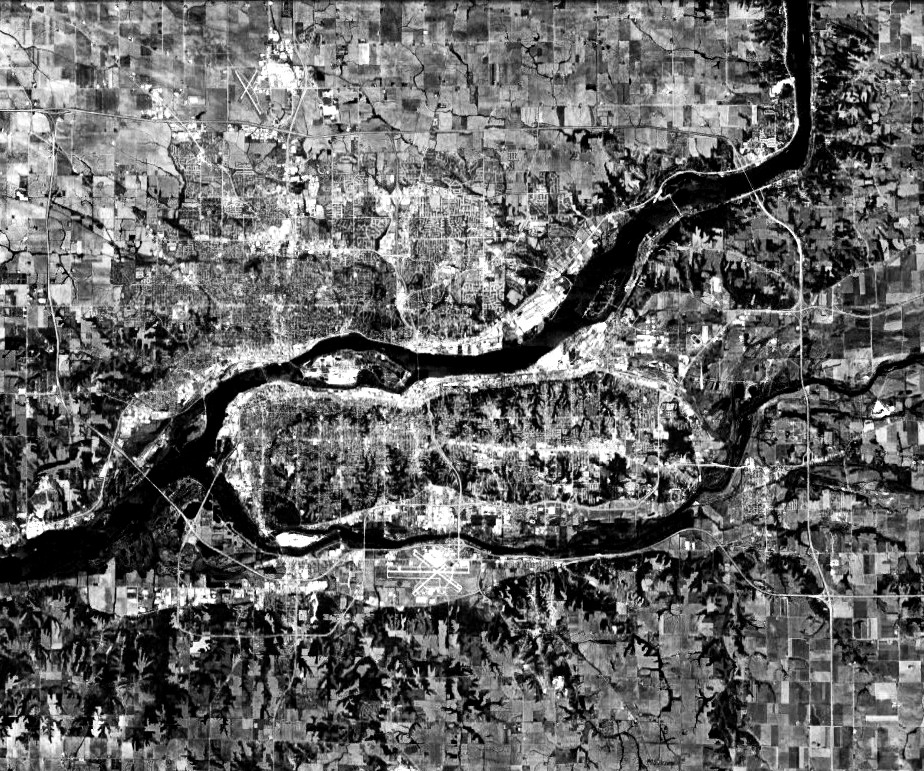
Mar '12 - Apr '15

"The Middle" [an impromptu name for my research] takes up the question of middle-urbanism, i.e., contexts which can neither be described as urban, suburban, or rural, or the endless classifications to prop up over the last several years. As the urbanization of the world become more prominent in architectural discourse and beyond, the middle-urban sites pose somewhat of a conundrum. Rather than hold the metropolis as the holy grail for urbanism, The Middle highlights cities whose positions are integral to local economies, yet have no particular impetus to grow, densify, or urbanize.
Quad Cities envelopes the Mississippi River, comprised of Davenport and Bettendorf West of the River in Iowa, and Moline and Rock Island on the East side in Illinois. And it just so happens that Rock Island Arsenal, the largest government-owned weapons manufacturing site in the country, sits squarely in the middle of the mighty Mississippi. Although the arsenal is quite a lot to wrap one's head around, Quad Cities holds several peculiarities that refer back to the problematic scalar definitions. Although comprised of individual municipalities, the cities' economies, cultures, and residents are inextricably linked, softening political boundaries of city, county, and state.
[shop interior at Rock Island Arsenal, 1918]
Out of curiosity, I've been searching for the term "middle-urbanism" in architectural discourse, and have yet to find anything. Now's probably a good time to coin the term.
Now that I'm post-graduate-school, and [for the time being] post-architectural-practice, I'm using this blog as an outlet to generate meaningful conversation on the limitations as well as latent opportunities in architectural practice. Co-Founder @anewyorkagency



4 Comments
Your definition of "middle-urbanism" isn't very concise at this point, which makes relating it to other discourse challenging. Regardless, it sounds like a type of place. I would be interested in hearing about what defines this place in greater depth, rather than defining it negatively (ie. it's not A, or B, or C, so I present to you D). I have heard the phrase "Middle Urbanism" used, but not to define a place type, but rather as an alternative architectural/urban design theory which sits between two opposing urban intervention strategies (Empiricism vs. Imposition). It comes from Michael Piper, partner of DUB Studios in New York (as far as I know. There may be other precedents). He is teaching a course at the Daniel's Faculty of Architecture, Landscape and Design at the University of Toronto this semester called "Forming Middled Urbanisms." If you're trying to locate your idea as a place type in the discourse of urbanism, I would recommend reading a lot on urban theory, say Pier Vittorio Aureli's "Possibility of an Absolute Architecture," Rem Koolhaas "S,M,L,XL - Post-Urbanism", and Peter Hall "Cities of Tomorrow."
I'm all for middle-earthbanism, personally:
Snark aside:
Check out Michael Dear's writings on "the border" as an urbanistic pattern (specifically his work on San Diego/Tijuana), and how changing conditions on one side affect growth/contraction on the other. I know he mentions more people and sources that I can't remember offhand, but it feels relevant to your description of the Quad Cities (though substituting a geophysical border for a political border, that is).
Nathan_B, all very valid points, and Michael Piper's work looks promising. I plan to unfold the Middle-Urbanism theory more concisely through specific reflections on historical precedent and projective imaginaries of the Quad Cities context. It does seem to me thus far that very little emphasis has been placed on the non-metropolis cities that have neither been absorbed by mega-cities, nor fit into the suburb classification.
The quick, abstract-length texts seem to fit Archinect's audience, but posts will probably get lengthy as the year progresses.
royc that image is loaded! I almost want to change contextual focus to...anywhere with a super steppe cliff. The topic of border is also something I want to address at some point, though more directed at the Mississippi as porous border of pre/post Homestead Act expansion westward, and what condition the river as border currently portrays, given the residents of each municipality are quite mobile, as far as economy and leisure go.
Cheers,
D
Block this user
Are you sure you want to block this user and hide all related comments throughout the site?
Archinect
This is your first comment on Archinect. Your comment will be visible once approved.